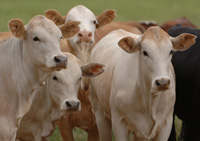 References to spayed heifers are not uncommon in early accounts of the American cattle industry. The castration of calves with a few quick slices of a cowboy’s blade is easy to imagine as part of the perennial process of roundups on the open range. But how did the same cowboys remove ovaries, when the mortality rate for human abdominal surgery was more than 50 percent in the latter part of the nineteenth century?
References to spayed heifers are not uncommon in early accounts of the American cattle industry. The castration of calves with a few quick slices of a cowboy’s blade is easy to imagine as part of the perennial process of roundups on the open range. But how did the same cowboys remove ovaries, when the mortality rate for human abdominal surgery was more than 50 percent in the latter part of the nineteenth century?
Rollie Burns explained the process in the book “Rollie Burns: An Account of the Ranching Industry on the South Plains,” by W.C. Holden. Burns, born in 1857, covered the range as a buffalo hunter, bronc buster, cowboy, drover, and rancher. When he became manager of the IOA Ranch in Lubbock County, Texas, in 1888, he was in charge of over 330,000 acres with an annual calf crop of between 4,000 to 7,000 head. Although one season his crews branded 7,500 calves, with fires stoked by dried cow chips because the land was so arid that brush was often hard to find.
The IOA routinely spayed heifers they expected to use for beef, at three or four years of age. Spaying meant that the heifers would be easy to manage with steers of the same age. But the process required more skill than castration and could not be performed on the roundup ground.
“The female calves had to be held and driven to headquarters, where special equipment and a pasture were provided,” explained Rollins.
“There were two methods of spaying. The old way was to pull the heifer up by the heels with a block and tackle attached to a heavy cross-beam supported by two tall posts. An incision about four inches long was made, and the ‘doc’ ran his fingers in and removed the ovaries.
“The incision was sewed up and the animal was then driven into another corral so that she would not have to be choused around any more. After that it was better to keep the heifers in separate pens for a few weeks until the wounds healed.”
In the second method mentioned by Rollins, the heifer was driven into a chute, where small incisions for removal of the ovaries were made in the flanks, just in front of the hip bones. This technique and vaginal removal are the procedures used for spaying heifers, today.
